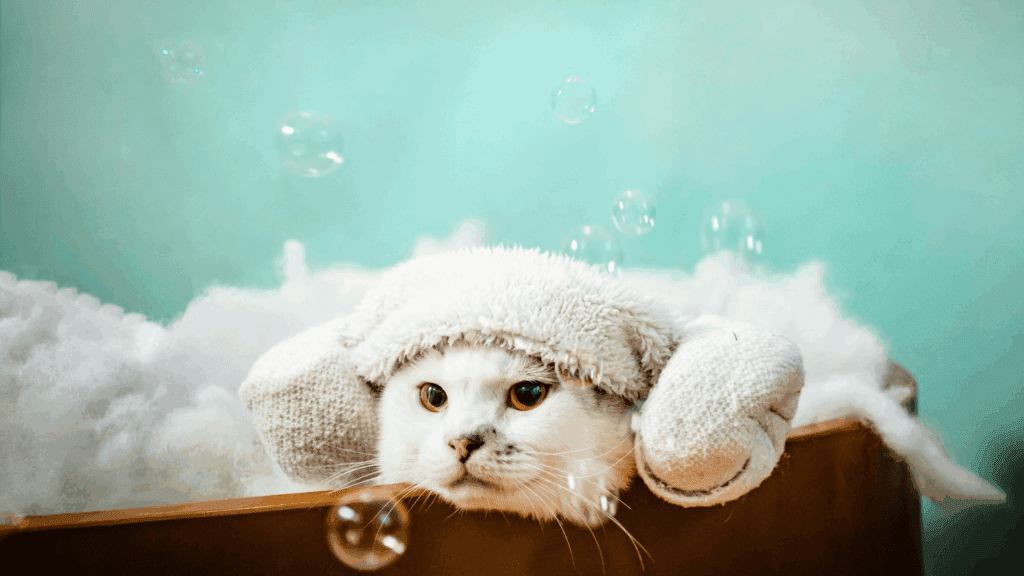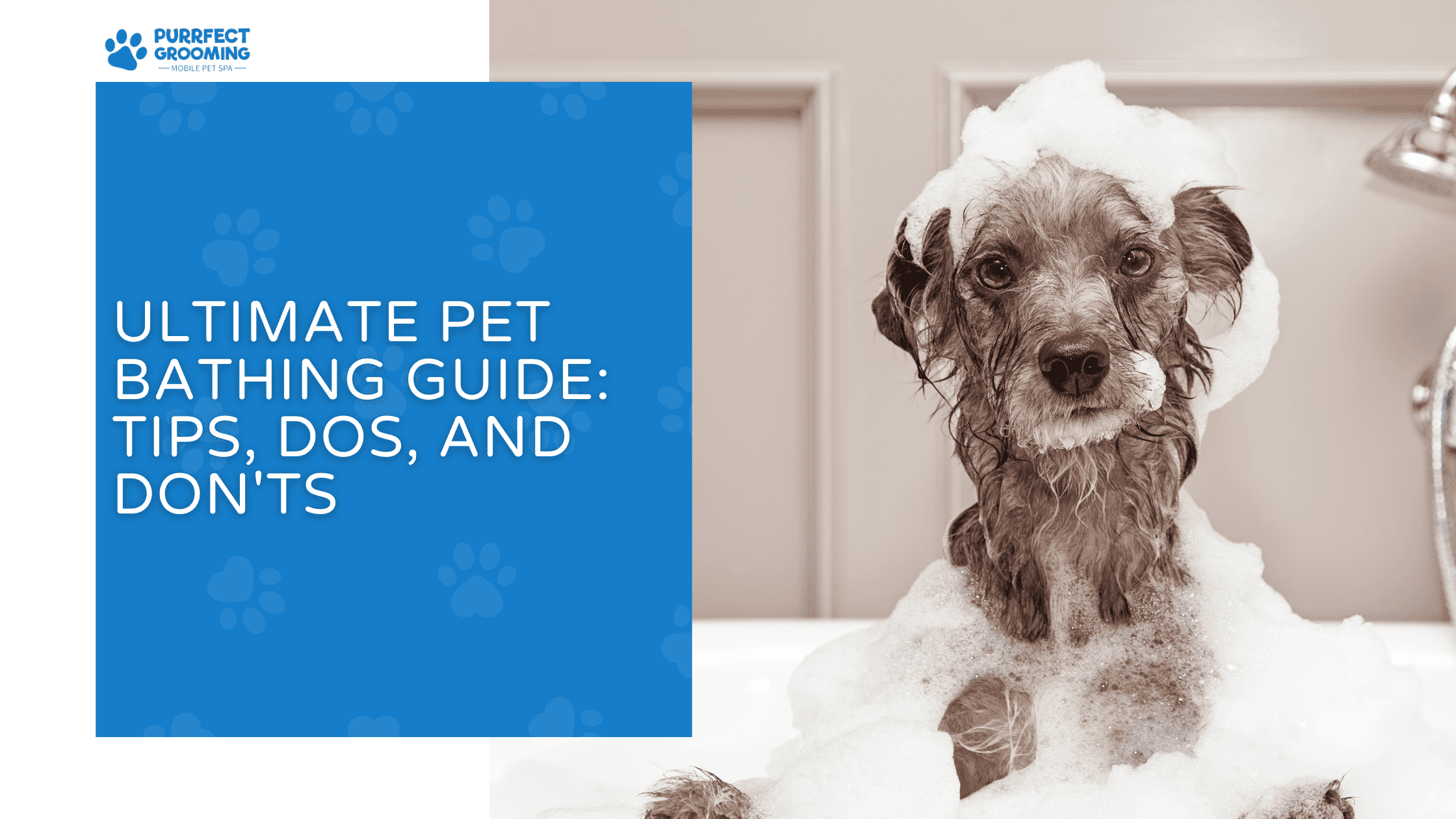Ultimate Pet Bathing Guide: Tips, Dos, and Don’ts
Bathing your pet is more than just a routine chore,it’s an essential part of their overall hygiene and health. Regular baths help keep their coat clean, free of dirt, and reduce the risk of skin infections. However, it’s crucial to follow the proper steps and guidelines to ensure the process is safe and comfortable for your furry friend. In this comprehensive guide, we’ll cover the dos and don’ts of bathing your pet to make bath time a positive experience for both of you.
Bathing pets is more than just keeping them clean—it plays a big role in their overall health and comfort. In fact, a survey by the American Pet Products Association (APPA) revealed that 67% of U.S. households, or about 87 million families, own a pet, and regular bathing is one of the most common care routines among them . With professional grooming costs rising, many pet parents are choosing to bathe their pets at home, not only to save money but also to ensure their furry friends stay fresh, healthy, and happy.

Preparing for the Bath
Choosing the Right Time
Timing is everything when it comes to bathing your pet. Choose a time when your pet is calm and relaxed. Avoid scheduling a bath right after a meal or when your pet is overly energetic. Late afternoon or early evening can often be a good time. Bathing a stressed or anxious pet can make the process more difficult for both of you.
Gather Your Supplies
Before starting, make sure you have all the necessary supplies within reach. You’ll need pet-safe shampoo, towels, a non-slip mat, a brush, and a cup or spray nozzle for rinsing. Having everything ready will make the process smoother and less stressful. Additionally, if you have a blow dryer designed for pets, keep that handy for drying after the bath.
Brush Before Bathing
Brushing your pet before the bath helps remove loose fur, dirt, and tangles. This step is particularly important for long-haired breeds, as it prevents matting and makes the bathing process more effective. Brushing also helps stimulate the skin and distribute natural oils, which is beneficial for your pet’s coat.
Safety Measures
Ensure your pet’s safety by placing a non-slip mat in the bathing area. This will prevent slipping and provide a secure footing. Also, keep your pet’s ears and eyes protected from water and shampoo by using cotton balls or a specially designed bathing cap. Safety measures are especially important to avoid accidents and ensure a positive experience.
The Bathing Process
Proper Water Temperature
The water temperature should be lukewarm, similar to what you’d use for a baby. Water that is too hot or too cold can cause discomfort or even harm your pet. Testing the water with your wrist or elbow can help you gauge the right temperature. A comfortable temperature will help your pet feel relaxed during the bath.
Using Pet-Safe Shampoo
Always use a shampoo specifically formulated for pets. Human shampoos can be too harsh for their skin and may cause irritation. Follow the instructions on the shampoo bottle for the right amount to use. Some shampoos are designed for specific coat types or skin conditions, so choose one that suits your pet’s needs. A pet-safe shampoo will ensure that your pet’s skin and coat remain healthy.
Washing Techniques
Head and Face
Start with the head and face, being extra careful around the eyes and ears. Use a damp cloth or sponge to clean these sensitive areas gently. Avoid getting water and shampoo directly in the eyes and ears. Keeping these areas dry and clean will prevent infections and discomfort.
Body
Work your way down the body, lathering the shampoo thoroughly. Use gentle, circular motions to massage the shampoo into your pet’s coat. Be sure to clean under the collar, armpits, and other areas that are often overlooked. This technique helps remove dirt and distributes the shampoo evenly.
Paws and Tail
Pay special attention to the paws and tail, as these areas can accumulate a lot of dirt. Use your fingers to scrub between the toes and under the tail. Cleaning these areas thoroughly helps prevent infections and keeps your pet comfortable.
Post-Bath Care
Rinsing Thoroughly
Rinsing is a critical step to ensure all the shampoo is removed from your pet’s coat. Any leftover residue can cause skin irritation. Use clean water and rinse until the water runs clear. Thorough rinsing helps maintain your pet’s skin health and prevents irritation.
Drying Your Pet
Gently squeeze out excess water from your pet’s coat before wrapping them in a towel. Pat dry instead of rubbing to avoid tangling the fur. For long-haired pets, you may need to use a blow dryer on a low, cool setting, but be sure to keep it at a safe distance to prevent burns. Proper drying techniques help maintain the texture and health of your pet’s coat.
Brushing Again
Once your pet is dry, give them another thorough brushing. This helps remove any remaining loose fur and keeps their coat looking smooth and shiny. Brushing also helps distribute natural oils and prevents tangling, ensuring your pet’s coat remains healthy and manageable.
Dos and Don’ts of Bathing Your Pet
Dos
- Do Use Lukewarm Water
Lukewarm water is comfortable for your pet and prevents any thermal shock. It helps keep your pet relaxed and makes the bathing process smoother.
- Do Be Gentle
Handle your pet with care throughout the bath to keep them calm and relaxed. Gentle handling ensures a positive experience and prevents stress or anxiety.
- Do Use Appropriate Products
Using products specifically designed for pets ensures their safety and skin health. Pet-safe products are formulated to match their skin pH and are less likely to cause irritation.
- Do Rinse Completely
Make sure to rinse off all shampoo to avoid skin irritation. Proper rinsing ensures that no residue is left on the skin, which can cause itching or discomfort.
Don’ts
- Don’t Use Human Shampoo
Human shampoo can disrupt your pet’s skin pH balance and cause irritation. Always choose a shampoo formulated for pets to avoid skin problems.
- Don’t Bathe Too Often
Frequent baths can strip the natural oils from your pet’s coat, leading to dry skin. Stick to a bathing schedule that suits your pet’s needs, usually once a month or as recommended by your vet.
- Don’t Forget to Protect Ears and Eyes
Water and shampoo in the ears or eyes can cause infections and discomfort. Use cotton balls to protect the ears and be cautious around the eyes to prevent any irritation.
- Don’t Rush the Process
Take your time to ensure your pet is thoroughly clean and comfortable throughout the bath. Rushing can cause stress and may lead to an incomplete bath.
Special Considerations
Bathing Puppies and Kittens
Puppies and kittens have more sensitive skin and require gentler care. Use a mild shampoo and be very gentle when handling them. Their young skin is more prone to irritation, so extra care is needed.
Bathing Senior Pets
Older pets may have arthritis or other conditions that make bathing more challenging. Use a non-slip mat and provide extra support during the bath. Be patient and gentle to avoid causing any discomfort.
Bathing Pets with Medical Conditions
If your pet has a medical condition, consult your vet before bathing. They may recommend specific products or techniques to ensure your pet’s safety. Following your vet’s advice ensures that the bath does not exacerbate any health issues.
Common Mistakes to Avoid
Over-Bathing
Too many baths can lead to dry, irritated skin. Stick to a bathing schedule that suits your pet’s needs, and consult your vet if you’re unsure. Over-bathing strips the natural oils from your pet’s skin, causing dryness and irritation.
Incorrect Drying Techniques
Rubbing vigorously with a towel can cause matting and tangles. Pat dry instead. Proper drying techniques help maintain the texture and health of your pet’s coat.
Neglecting Regular Grooming
Bathing is just one part of your pet’s grooming routine. Regular brushing and nail trimming are also essential for their health. A comprehensive grooming routine ensures that your pet’s coat and skin remain healthy and free of issues.
Conclusion
Bathing your pet can be a rewarding experience that strengthens your bond. By following these dos and don’ts, you can ensure that bath time is safe, comfortable, and even enjoyable for your furry friend. Remember, the key to a successful bath is preparation, patience, and using the right techniques and products.
You May Also Like : How Often Should You Bathe Your Dog
FAQs
1. How often should I bathe my dog?
It depends on the breed and lifestyle, but generally, once a month is sufficient. Dogs with oily coats or skin conditions may need more frequent baths. Consult your vet for personalized advice.
2. Can I use conditioner on my pet?
Yes, you can use a pet-safe conditioner to keep their coat soft and manageable. Be sure to rinse thoroughly to avoid any residue. Conditioners help in maintaining the coat’s moisture and texture.
3. What should I do if my pet hates baths?
Try to make bath time fun with treats and positive reinforcement. Start with short, positive experiences and gradually increase the duration. Creating a calm and positive environment helps your pet associate baths with positive outcomes.
4. Are there any alternatives to traditional bathing?
Yes, you can use pet wipes or dry shampoos as an alternative to traditional baths, especially for quick clean-ups. These alternatives are useful for maintaining hygiene between regular baths.
5. How do I keep my pet calm during a bath?
Keep the environment calm and quiet. Speak to your pet in a soothing voice, and use treats and praise to reward good behavior. A calm approach and positive reinforcement make the bath a less stressful experience.
